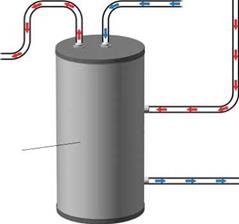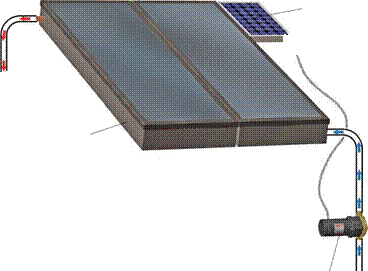Using Solar for Space Heating
Solar collectors are commonly used for domestic hot water, but they also can supplement both forced-air and hydronic heating
systems. In Europe, says Tim Merrigan of the National Renewable Energy Laboratory in Boulder, Colo., package systems that do both are relatively common. But due to heavy winter-heating loads and reduced solar potential, homeowners in this country shouldn’t expect to get much more than one-third of their winter heat from solar sources with today’s technology.
Elia Kleiman, the president of Synepex Energy in Cambridge, Mass., says the proportion of winter heat from solar depends on the type of heating system, the amount of insulation installed, and the tightness of the house. A best-case scenario in New England, land of snowy winters and cold, dreary springs, is that a solar system meets 40% to 70% of the heating load. That’s in a well-sealed house with a radiant-floor heating system.
Radiant-floor heating is especially well suited to solar hot-water systems because it requires lower water temperatures, 120°F versus the 180°F that would be pumped through a typical baseboard hydronic system. Solar hot water also can be used for newer forced-air systems that use a technology called "hydro air." These boilers heat water forced through a heat-transfer coil, where it warms outgoing air.
For a hypothetical house of roughly 2,500 sq. ft.—well insulated and well sealed—Kleiman says Synepex would probably recommend eight evacuated-tube collectors covering roughly 400 sq. ft. of roof. That would provide 100% of domestic hot water in addition to what the system supplied to the space-heating side.
Systems like that aren’t cheap. Although it’s difficult to offer meaningful numbers without knowing specifics, Kleiman says that a solar-radiant floor system could easily cost $16,000 and possibly as much as $24,000 before tax credits and rebates. That’s many times more than a system designed for only domestic hot water. If the collectors were tied to a baseboard hot-water system rather than a radiant floor, a homeowner
|
1 |
How Much Will My System Cost? |
|
ost is a key consideration when weighing the value would increase by as much as $3,690, merits of renewable energy, not only because the my annual utility savings would be from $224 to systems tend to be expensive, but also because they $335, and I would remove 21 tons of greenhouse force us to think about energy in an entirely different gases from the air. That’s the equivalent of way. A conventional water heater doesn’t cost much, 42,000 auto miles. but it’s expensive to operate over its lifetime. A solar Years to break even? Between three and four, hot-water system is much more expensive up front but not including the system’s impact on property-value costs less to use. appreciation. If I wanted estimates, a link would Thinking in generalities isn’t helpful when it comes take me to a list of local installers, complete with to deciding whether solar hot water is a reasonable contact information, services offered, and a brief investment. For specifics, I went to www. findsolar summary of their experience. .com, a website run under the auspices of the Depart – 2. In Tucson, Ariz., where utility rates are lower but the ment of Energy the American Solar Energy sun shines brighter, a similarly sized system would and the Solar Electric power Association. Its an excel – produce between $252 and $378 in annual utility lent place to get started on a hot-water system and savings provides a variety of other useful links. 3. In Pensacola, Fla., lower state incentives and utility A worksheet let me plug in a lot of specifics: my rates drive the savings down to a range between state, county, electric utility, and the number of people $74 and $110. living in the house. In just a few seconds, the site came up with the size of the system I’d need, length 4. In Daytor1, Ohia the savings are about Ию same as of payback, annual utility savings, and even return on in Pensacola (about $85 per year). investment. If electricity rates increase more in the future than 1. In southern Maine, I’d need one collector of about now forecast solar hot water wiN become a viable 32 sq. ft. to produce the 35 gal. of hot water my option for more people. Until then, when it comes to wife and I would use in a day. Having the system saving money with solar hot water, rt seems that if you installed would cost about $3,500, but after a have high utility rates, you’d be smart to get a system state rebate and the federal tax credit, the net cost on your roof. If not the decision depends on your com – would be less than half that. Moreover, my property mitment to a cleaner environment. Map indicates an annual average of daily kwh/m2/day know* hours per square meter per day solar-radiation potential for a south-facing flat collector array, mounted at an angle equal to its latitude. Data courtesy of National 4-4.5 4.5-5 5-5.5 5.5-6 6-6.5 6.5 Renewable Energy Laboratory. |
Active Systems Reduce Heat Loss

![]()





![]()

 |
In active systems, electric pumps speed circulation to reduce heat loss. As illustrated here, water is run through flat-plate collectors (essentially heat collectors plumbed with a network of copper pipe) to the water heater. In areas subject to occasional freezing, an optional valve drains water into a secondary storage tank when its temperature approaches 32°F. The Alternative Energy Store® (http://home. alten ergystore. com) sells an open-loop kit consisting of two large flat-plate collectors, hardware, and pump for about $3,600. Shipping and installation are not included.

might expect to see solar take care of only 20% to 40% of the heating load.
A big drawback of trying to heat a house with solar hot water is that demand is highest when the heat potential of the system is lowest. On an overcast day in northern New England, the sun is long gone by late afternoon, and the call for heat goes up accordingly. The answer is to store hot water generated during the day in storage tanks so that it can be used for heat when the sun goes down or when the days are cloudy. Tanks can be very large, 2,000 gal. or more, although Kleiman says newer systems can use much smaller tanks that hold as little as 200 gal.
Researchers are also looking down the road at promising new possibilities. Merri – gan, for example, describes one experimen
tal project in Canada where solar collectors are used to heat the ground when solar potential is abundant in summer. In winter, geothermal heat pumps can be used to extract the stored heat. This seasonal storage of heat is one idea that could make 100% solar heat possible in the future—even in Calgary, Alberta.






Leave a reply